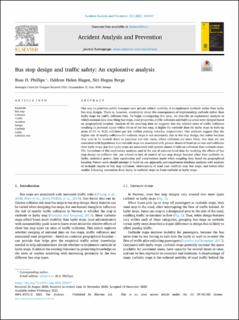| dc.contributor.author | Phillips, Ross Owen | |
| dc.contributor.author | Hagen, Oddrun Helen | |
| dc.contributor.author | Berge, Siri Hegna | |
| dc.coverage.spatial | Norway | en_US |
| dc.date.accessioned | 2021-07-13T09:28:14Z | |
| dc.date.available | 2021-07-13T09:28:14Z | |
| dc.date.created | 2021-03-19T10:26:44Z | |
| dc.date.issued | 2021-02-09 | |
| dc.identifier.citation | Accident Analysis & Prevention. 2021, 153 (April 2021), 1-11. | en_US |
| dc.identifier.issn | 0001-4575 | |
| dc.identifier.uri | https://hdl.handle.net/11250/2764253 | |
| dc.description.abstract | One way to prioritize public transport over private vehicle mobility, is to implement curbside rather than layby bus stop designs. There is, however, uncertainty about the consequences of implementing curbside rather than layby stops for traffic collision risks. To begin investigating this issue, we describe an exploratory analysis in which national data describing bus stops, road properties, traffic collisions and built-up areas were merged based on geographical location. Analysis of the resulting data set suggests that the relative rates of traffic collisions resulting in personal injury within 60 m of the bus stop, is higher for curbside than for layby stops in built-up areas (0.32 vs. 0.22 collisions per ten million passing vehicles, respectively). Our analyses suggest that the higher risk of nearby collisions for curbside stops is not necessarily due to bus stop design, but rather because they tend to be located closer to junctions and side roads, where collisions are more likely. Our data are not consistent with hypotheses that curbside stops are associated with greater shares of head-on or rear-end collisions than layby stops, nor that layby stops are associated with greater shares of side-on collisions than curbside stops. The limitations of this exploratory analysis, and of the use of national-level data for studying the effects of bus stop design on collision risk, are related to lack of control of bus stop design features other than curbside vs. layby, statistical power, data registration and compromises made when coupling data based on geographical location. Future work should attempt to build on our approach, and supplement database analyses with analysis of in-depth reports of bus stop collisions, observations of road user conflicts near bus stops, and before-after studies following conversion from layby to curbside stops or from curbside to layby stops. | en_US |
| dc.language.iso | eng | en_US |
| dc.publisher | Elsevier | en_US |
| dc.rights | Attribution-NonCommercial-NoDerivatives 4.0 Internasjonal | * |
| dc.rights | Attribution-NonCommercial-NoDerivatives 4.0 Internasjonal | * |
| dc.rights.uri | http://creativecommons.org/licenses/by-nc-nd/4.0/deed.no | * |
| dc.title | Bus stop design and traffic safety: An explorative analysis | en_US |
| dc.type | Peer reviewed | en_US |
| dc.type | Journal article | en_US |
| dc.rights.holder | © 2021 The Authors. Published by Elsevier Ltd. | en_US |
| dc.source.articlenumber | 105917 | en_US |
| dc.description.version | publishedVersion | en_US |
| cristin.ispublished | true | |
| cristin.fulltext | original | |
| cristin.qualitycode | 1 | |
| dc.identifier.doi | 10.1016/j.aap.2020.105917 | |
| dc.identifier.cristin | 1899223 | |
| dc.source.journal | Accident Analysis and Prevention | en_US |
| dc.source.volume | 153 | en_US |
| dc.source.issue | April 2021 | en_US |
| dc.source.pagenumber | 1-11 | en_US |

